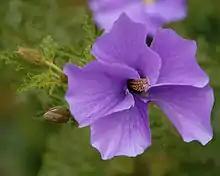| Alyogyne | |
|---|---|
 | |
| Alyogyne huegelii | |
| Scientific classification | |
| Kingdom: | Plantae |
| Clade: | Tracheophytes |
| Clade: | Angiosperms |
| Clade: | Eudicots |
| Clade: | Rosids |
| Order: | Malvales |
| Family: | Malvaceae |
| Subfamily: | Malvoideae |
| Tribe: | Gossypieae |
| Genus: | Alyogyne Alef. |
| Species | |
|
See text | |
Alyogyne is a genus of flowering plants in the family Malvaceae which are endemic to Australia. Its species were formerly in the genus Hibiscus but were split off starting in 1863 with H. hakaeifolius. In 1915 Lewton transferred H. cuneiformis and in Fryxell (1968) H. pinonianus and H. huegelii followed. A recent revision has created many new species.
The name Alyogyne comes from the Greek words "alytos" (undivided) and "gyne" (female). "Gyne" referers to the styles which are female parts of a flower. In Hibiscus, the style is branched below the stigmas but in Alyogyne it is undivided.
Species include:
- Alyogyne cravenii
- Alyogyne cuneiformis (coastal hibiscus)
- Alyogyne hakeifolia
- Alyogyne huegelii (lilac hibiscus)
- Alyogyne pinoniana (sand hibiscus)
References
External links
- Colleen Keena (December 2002). "Alyogyne: An Update". Australian Plants online. Association of Societies for Growing Australian Plants. Archived from the original on 12 January 2008. Retrieved 12 April 2008.
- FloraBase - the Western Australian Flora: Alyogyne
 Media related to Alyogyne at Wikimedia Commons
Media related to Alyogyne at Wikimedia Commons
This article is issued from Wikipedia. The text is licensed under Creative Commons - Attribution - Sharealike. Additional terms may apply for the media files.